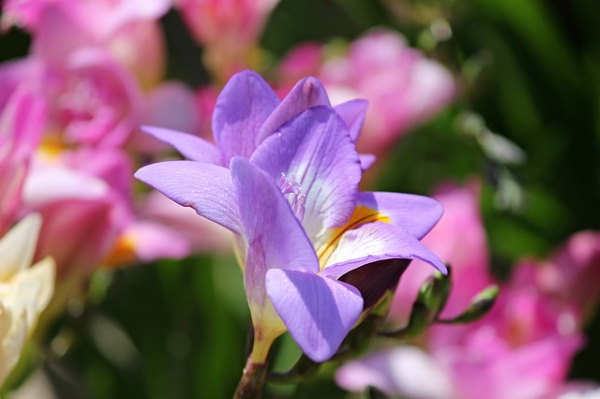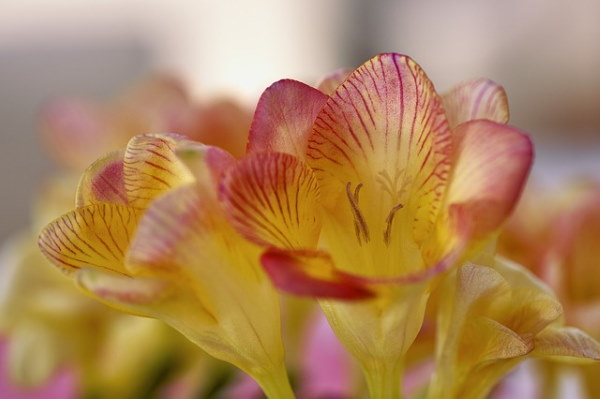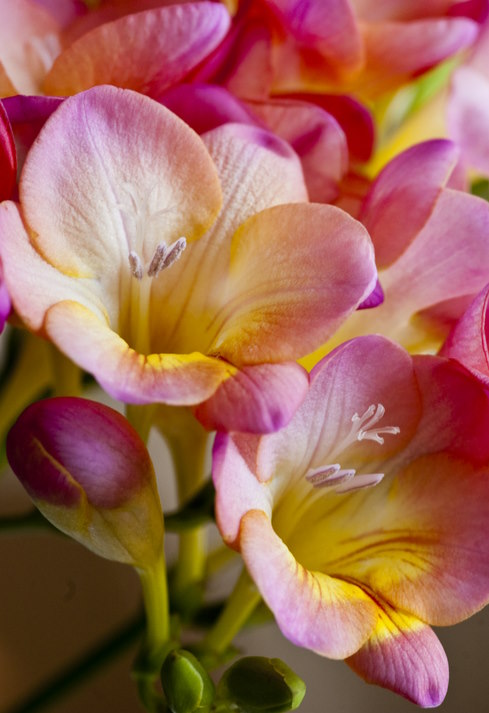How to Grow Freesia Flower Indoors
Freesia flower is often sold as cut flowers in florist's shops. You can enjoy their colorful, intoxicatingly fragrant blooms even longer, though, if you grow freesias yourself as house plants.
Freesia is easy to grow indoors. Get how-tos for planting bulbs in pots, how to make them bloom, plus year-round care tips for these beauties.
 Beautifully fragrant freesias are also easy to grow indoors. Image by Manfred Richter
Beautifully fragrant freesias are also easy to grow indoors. Image by Manfred RichterGet to Know Freesia Flowers
Funnel-shaped freesia flowers are sweetly-scented and available in single- and double-flowered varieties. Hybrids offer a big range of gorgeous colors -- lavender, pink, orange, red, yellow, white and bicolors. Surrounding the flower stems are long, strap-like leaves.
How big do they get? Freesias will reach a height of up to 18 in (46 cm). Flower stems often need to be staked to hold them upright.
Freesia bulbs are actually corms, and are easy to grow indoors. Native to South Africa, they are warm-natured, meaning corms don't need a cold treatment to bloom; the corms are ready to plant.
Choose corms that are firm -- not soft or mushy. Don't buy any that are sprouting. After waiting for months for freesia flower to bloom, you don't want to be disappointed.
When to Plant Freesia Bulbs
Start planting freesia in late summer or early fall for winter or early-spring blooms. You can pot them up every couple weeks for a succession of flowers to enjoy for months.
 Freesia is a genus in the Iridaceae family, along with iris, gladiolus and crocus. Photo T. Wolter
Freesia is a genus in the Iridaceae family, along with iris, gladiolus and crocus. Photo T. WolterHow to Grow Freesia Bulbs Indoors - Step by Step
- Choose a shallow pot (at least 3 in/7 cm deep) with drainage holes in the bottom. Fill the pot loosely with potting mix. Set corms 2 in (5 cm) apart, pointed end up. Do not press the corms into the mix, keep it loose so the roots can grow through it easily. Top corms with 1 in (2.5 cm) of additional potting mix.
- Water minimally until you see new growth.
- Move pot to a bright, warm (80°F/27°C) location such as a sunroom for about 8 weeks. Keep the medium barely moist.
- When shoots reach about 2 in (5 cm) tall, move the pot to a cooler (60-65°F/16-18°C) room in a bright window for a couple weeks until flower buds form. Turn the pot every couple days for even growth. When in full bloom, keep freesias in a bright location out of direct sun to prolong the bloom.
What to Do After Flowering is Over
After all the flowers are spent, reduce watering and allow the foliage to die back naturally.
When the foliage turns brown, stop watering. Then cut them off. Lift the corms out of the potting medium and store them in a dry, warm (80°F/17°C) place for at least 3 months. Corms need at least a 3-month rest before they can be started again. Any rotten or corky corms likely have dry rot and should be discarded.
Freesia Flower Problems, Solutions and Answers
Leaning stems are likely stretching toward the sunlight. It's a good idea to turn the pot every few days, or as necessary, to expose all sides to light. Also, it's not unusual to stake up flowering freesias because they get top heavy and flop over.
Shriveled, quickly fading blooms are caused by too-high temperatures. Make freesia last longer by keeping the plant in a slightly cooler location. Blooms will last for months if kept at a maximum of 65°F/18°C.
Something bugging your freesias? Aphids are attracted to new growth; look for these insects on leaves and stems and treat any infestation right away. Red spider mites sometimes attack indoor plants in winter because they like dry conditions. Raising the humidity will help to prevent them.
Are freesias poisonous? No. While it's not a good idea to allow cats and dogs to chew on plants, you don't have to worry about this one -- it's non-toxic.
 Image ©Kazakov / istockphoto
Image ©Kazakov / istockphotoFreesia Flower Care Tips
Light: Bright, indirect sunlight. Some cool, direct morning sunlight is fine.
Water: Keep the soil lightly moist. Don't overwater because it will cause the corms to rot.
Humidity: Moderate -- around 40-50% relative humidity. If indoor air is dry, discover these easy ways to increase humidity for your houseplants.
Temperature: Warm temperatures 80°F/27°C until corms start sprouting, then keep cool 60-65°F/16-18°C while freesia plant is growing and flowering. Freesias may stop blooming when temps rise above 70°F/21°C.
Soil: Good-quality, all-purpose potting mix with added horticultural sand for faster drainage.
Fertilizer: Feed every 2 weeks, beginning with the first show of flower buds till the end of flowering. Use a high-phosphorus water-soluble fertilizer.
Propagation: Repot corms each year, following "How to Grow Freesia" steps above. Corms grow offsets that can be separated and potted.


